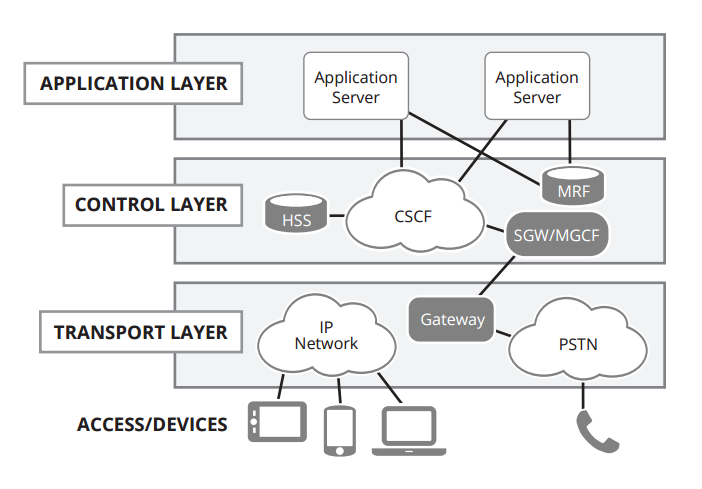IP Multimedia Subsystem or IMS is a standards-based architectural framework for delivering multimedia communications services such as voice, video and text messaging over IP networks. The IMS specifications were originally created by the 3rd Generation Partnership Project (3GPP) to standardize the implementation of these services on next-generation mobile networks.
How is IMS used in telecom?
IMS is a crucial architectural framework of modern telecom networks, supporting services like VoLTE (Voice over LTE), VoWiFi (Voice over Wi-Fi), and RCS (Rich Communication Services). It has enhanced the quality and functionality of voice and messaging services. IMS is also the solution for globally interoperable voice and communication services in 5G networks, as circuit-switched networks are no longer supported in 5G standalone deployments
How does IP Multimedia Subsystem (IMS) Architecture work?
The IP Multimedia Subsystem architecture decomposes the network into distinct application, control, and transport layers with standardized interfaces to promote scalability, flexibility, and extensibility. An oversimplified IMS architecture is depicted in the figure below.
IMS enables secure and reliable multimedia communications between diverse devices across diverse networks. The architectural model provides a unified infrastructure and common mechanisms for controlling, manipulating, routing, and managing sessions. It also specifies how to implement authentication, authorization, and accounting controls. The IMS specifications incorporate widely used Internet Engineering Task Force (IETF) recommendations such as the Session Initiation Protocol (SIP) for session control signaling.
The control layer, often referred to as the IMS core, is the cornerstone of the architecture responsible for regulating communications flows. The main functional elements of the control layer include:
- Application Servers – these are applications providing services, such as telephone call control, call continuity, conference calling, and supplementary service configuration
- Call Session Control Function (CSCF) – the heart of the IMS architecture, is responsible for controlling sessions between endpoints (referred to as terminals in the IMS specifications) and applications, and is crucial in ensuring seamless and secure communication services
- Home Subscriber Server (HSS) – the master database that maintains all user profile information used to authenticate and authorize subscribers
- Signaling Gateway (SGW) and Media Gateway Control Function (MGCF) – respectively provide SS7 and MGCP interoperability with the PSTN
- Media Resource Functions (MRF) – provides media-related functions such as the playing of tones and digital announcements
Many IMS functions are further deconstructed into distinct functional elements. For example, the CSCF function encompasses three discrete roles: Serving-CSCF (C-CSCF), Interrogating-CSCF (I-CSCF), and Proxy-CSCF (P-CSCF).
What are the Advantages and Benefits of IP Multimedia Services?
By defining a layered network architecture with open interfaces IMS provides greater flexibility and extensibility compared to traditional monolithic communications network architectures. IMS advantages and benefits for service providers include:
- Application, network, and device independence: Applications are decoupled from the transport layer. Service providers can deliver common applications and services, with unified authentication, authorization, and accounting across diverse devices in 4G and 5G mobile networks, Wi-Fi networks, fixed networks, and MSO networks.
- Reusable components: Reduce CAPEX and OPEX by leveraging common IMS functional elements to support multiple services
- Standards-based solutions: By deploying standards-based network elements, service providers can eliminate vendor lock-in and contain costs.
- Service interconnection: Leverage standard mechanisms for peering and interconnecting distinct communications service provider networks and for enabling seamless roaming across networks.
- Service coverage: IMS standards cover a wide range of IP-based communications services including voice, video, text chat, multiparty conferencing, and collaboration applications.
- Convergence: By evolving legacy TDM voice networks to converged all-IP networks that support voice and IP multimedia services, service providers can reduce OPEX
- Quality of service: IMS supports policy-based QoS mechanisms for SLA assurance and to ensure satisfactory user experiences.
What is Cloud-Native IMS?
Cloud-Native IMS is an advanced version of the IP Multimedia Subsystem designed to operate in cloud environments, which enables MNOs to deliver innovative voice and multimedia services efficiently.
The Cloud-Native IMS supports various voice services:
- Voice over LTE (VoLTE): Bridges voice services over LTE networks.
- Voice over New Radio (VoNR): Supports 5G by ensuring voice services over the new radio interface.
- Voice over WiFi (VoWiFi): Facilitates calls over WiFi networks, enhancing coverage and reliability.
- Voice over Broadband (VoBB): Supports voice services via broadband connections, ensuring flexibility.
Ribbon’s IMS is built using a microservices-based architecture that enhances scalability, efficiency, and operational flexibility. This design enables MNOs to deploy solutions rapidly, responding to market demands with agility.


